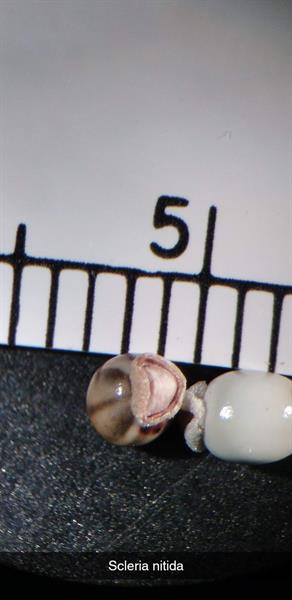
Contributed by Richard J. LeBlond
A genus of about 250 species, herbs, pantropical, extending into temperate regions. Recent work has brought clarity to portions of this genus occurring in the eastern United States, including the S. ciliata complex, where work remains to be done with S. pauciflora. Investigation of the S. triglomerata complex has led to the recognition of two older species, S. nitida and S. flaccida. When present, the hypogynium at the base of the achene is a critical identifying feature for many Scleria taxa. In some taxa, such as S. baldwinii and S. georgiana, the hypogynium is absent from the achene but remains attached to the summit of the pedicel. This little-understood condition may have descriptive potential. Hardened achenes are necessary for reliable identification to species. In the key, achene length includes hypogynium when present. The scale character applies only to the ultimate bracteate structure clasping the achene.
ID notes:Scleria superficially resembles Rhynchospora in the field, but mature specimens are readily recognized by the terete white, gray, or black bony achenes.
Key advice:Hardened achenes are necessary for reliable identification to species. In the key, achene length includes the achene body and hypogynium (when present). The scale character applies only to the ultimate bracteate structure clasping the achene.
Ref: Bauters et al. (2016); Bauters, Larridon, & Goetghebeur (2019); Core (1936); Fairey (1967); Goetghebeur In Kubitzki (1998b); Kessler (1987); LeBlond, Tessel, & Poindexter (2015); Reznicek, Fairey, & Whittemore (2002) In Flora of North America Editorial Committee (2002b). Show full citations.
Hover over a shape, letter, icon, or arrow on the map for definition or see the legend. Data for arrows not developed for genera and families which may have species only occurring outside the flora area.
 © Gary P. Fleming | Scleria minor | Original Image ⭷
© Gary P. Fleming | Scleria minor | Original Image ⭷ © Melanie Flood | Scleria muehlenbergii | Original Image ⭷
© Melanie Flood | Scleria muehlenbergii | Original Image ⭷ © Scott Ward | Scleria distans var. distans | Original Image ⭷
© Scott Ward | Scleria distans var. distans | Original Image ⭷ © Scott Ward | Scleria flaccida | Original Image ⭷
© Scott Ward | Scleria flaccida | Original Image ⭷ © Scott Ward | Scleria muehlenbergii | Original Image ⭷
© Scott Ward | Scleria muehlenbergii | Original Image ⭷ © Scott Ward | Scleria nitida | Original Image ⭷
© Scott Ward | Scleria nitida | Original Image ⭷ © Scott Ward | Scleria oligantha | Original Image ⭷
© Scott Ward | Scleria oligantha | Original Image ⭷ © Scott Ward | Scleria bellii | Original Image ⭷
© Scott Ward | Scleria bellii | Original Image ⭷ © Scott Ward | Scleria lithosperma var. lithosperma | Original Image ⭷
© Scott Ward | Scleria lithosperma var. lithosperma | Original Image ⭷ © Jay Horn | Scleria verticillata source | Original Image ⭷
© Jay Horn | Scleria verticillata source | Original Image ⭷ © Jake Smith | Scleria bellii | Original Image ⭷
© Jake Smith | Scleria bellii | Original Image ⭷ © Scott Ward | Scleria minor | Original Image ⭷
© Scott Ward | Scleria minor | Original Image ⭷Feedback
See something wrong or missing on about Scleria? Let us know here: (Please include your name and email if at all complicated so we can clarify if needed.)
Cite as...